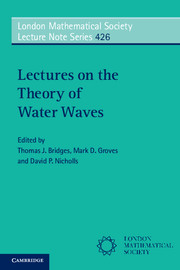Book contents
- Frontmatter
- Contents
- Contributors
- Preface
- 1 High-Order Perturbation of Surfaces Short Course: Boundary Value Problems
- 2 High-Order Perturbation of Surfaces Short Course: Traveling Water Waves
- 3 High-Order Perturbation of Surfaces Short Course: Analyticity Theory
- 4 High-Order Perturbation of Surfaces Short Course: Stability of Traveling Water Waves
- 5 A Novel Non-Local Formulation of Water Waves
- 6 The Dimension-Breaking Route to Three-Dimensional Solitary Gravity-Capillary Water Waves
- 7 Validity and Non-Validity of the Nonlinear Schrödinger Equation as a Model for Water Waves
- 8 Vortex Sheet Formulations and Initial Value Problems: Analysis and Computing
- 9 Wellposedness and Singularities of the WaterWave Equations
- 10 Conformal Mapping and Complex Topographies
- 11 Variational Water Wave Modelling: from Continuum to Experiment
- 12 Symmetry, Modulation, and Nonlinear Waves
- References
5 - A Novel Non-Local Formulation of Water Waves
Published online by Cambridge University Press: 05 February 2016
- Frontmatter
- Contents
- Contributors
- Preface
- 1 High-Order Perturbation of Surfaces Short Course: Boundary Value Problems
- 2 High-Order Perturbation of Surfaces Short Course: Traveling Water Waves
- 3 High-Order Perturbation of Surfaces Short Course: Analyticity Theory
- 4 High-Order Perturbation of Surfaces Short Course: Stability of Traveling Water Waves
- 5 A Novel Non-Local Formulation of Water Waves
- 6 The Dimension-Breaking Route to Three-Dimensional Solitary Gravity-Capillary Water Waves
- 7 Validity and Non-Validity of the Nonlinear Schrödinger Equation as a Model for Water Waves
- 8 Vortex Sheet Formulations and Initial Value Problems: Analysis and Computing
- 9 Wellposedness and Singularities of the WaterWave Equations
- 10 Conformal Mapping and Complex Topographies
- 11 Variational Water Wave Modelling: from Continuum to Experiment
- 12 Symmetry, Modulation, and Nonlinear Waves
- References
Summary
Abstract
An introduction to the new formulation of the water wave problem on the basis of the unified transform is presented. The main presentation is on the three-dimensional irrotational water wave problem with surface tension forces included. Examples considered are the doubly-periodic case, the linear case, the case of a variable bottom, and the case of non-zero vorticity.
Introduction
There have been numerous important developments in the study of surface water waves that date back to the classical works of Stokes and his contemporaries in the nineteenth century. A new reformulation of this problem was presented in [1]. This reformulation is based on the so-called unified transform or the Fokas method, which provides a novel approach for the analysis of linear and integrable nonlinear boundary value problems [2, 3].
This chapter is organised as follows: section 5.2 presents the novel formulation of the 3D water waves in the case of a flat bottom. This formulation is used in section 5.3 for the derivation of the associated linearized equations as well as a 2D Boussinesq equation and the KP equation. The case of the 2D periodic water waves is discussed in section 5.4. 3D water waves in a variable bottom are discussed in section 5.5. Finally, the case of 2D water waves with constant vorticity are considered in section 5.6.
A non-local formulation governing two fluids bounded above either by a rigid lid or a free surface is presented in [4]. The case of three fluids bounded above by a rigid lid is considered in [5]. A hybrid of the novel formulation and an approach based on conformal mappings is presented in [6].
3D Water Waves with Flat Bottom
Let the domain Ωf (where the subscript f denotes flat bottom) be defined by
where η denotes the free surface of the water. One of the major difficulties of the problem of water waves is the fact that η is unknown.
Let ϕ denote the velocity potential. The two unknown functions η(x1, x2, t) and ϕ(x1, x2, y, t) satisfy the following equations:
where is the gravitational acceleration, σ and ρ denote the constant surface tension and density respectively, and h is the constant unperturbed fluid depth.
- Type
- Chapter
- Information
- Lectures on the Theory of Water Waves , pp. 63 - 77Publisher: Cambridge University PressPrint publication year: 2016
References
- 2
- Cited by



